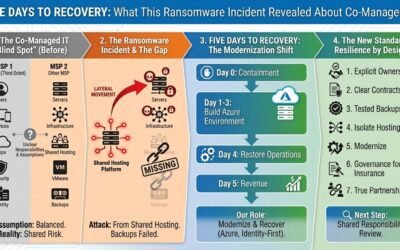Are you Investing Too Much or Too Little in Technology?
As small and medium-sized businesses (SMBs) continue to navigate the ever-evolving technological landscape, they often find themselves at one of two extremes:
- They either have too little technology and rely heavily on manual processes.
- They have too much technology, resulting in massive technology debt or overlap.
Both situations lead to inefficiencies and missed opportunities for growth and innovation. Rationalizing technology, processes, and people is essential to land in the “Goldilocks” spot of balanced technology, spending, strategy, and growth.
The Middle Ground: Ideal Strategy, Overspend Realities
A third scenario is having an ideal technology strategy but suffering from overspending. SMBs often underestimate the total cost of technology investments, including staff training, integration, cybersecurity, and ongoing overhead. Initial costs may seem manageable, but they can quickly escalate. Closing the gap between actual spending and real needs is crucial for sustained success and resilience against future challenges.
According to a recent study by CompTIA, 62% of respondents said technology is a primary factor in achieving their strategic business goals, while 31% deemed it a secondary factor. Only 5% claimed technology as a non-factor. Despite these variations, technology remains a critical competitive and growth enabler for businesses of all sizes and industries.
Rationalizing Technology
Rationalizing technology involves thoroughly examining a business’s technology assets and capabilities, understanding their full potential, and leveraging existing platforms to their fullest before adding new solutions. This clear understanding of the technology landscape allows businesses to identify and close gaps, leading to greater efficiency and productivity.
Why SMBs Struggle with Technology Management:
- Lack of Expertise: Many SMBs lack the in-house expertise or resources to manage their technology stack effectively, resulting in outdated tools and processes.
- Inefficiency: Investing in new solutions without rationalizing existing technology can lead to inefficiencies, overlap, and increased complexity.
Steps to Rationalize and Drive Value
- Inventory Existing Technology Assets: Conduct a comprehensive inventory of all hardware, software, and cloud services. Identify gaps and opportunities for consolidation. Involve employees in uncovering individual subscriptions to cloud services that aid their daily tasks.
- Consolidate Technologies: Review the inventory to find opportunities to streamline similar technologies. For example, consolidating multiple cloud storage services into a single platform can simplify processes and reduce costs.
- Review Usage and Licenses: Analyze technology usage and licensing agreements to uncover cost-saving opportunities. This includes identifying unused licenses or redundant subscriptions charging corporate accounts without being utilized.
- Optimize Existing Tools: Ensure current technology tools are used fully. For example, many businesses might use only a fraction of their software’s capabilities. Maximizing these tools can often meet needs without additional spending.
- Automate Manual Processes: Identify manual processes ripe for automation, such as data entry or invoice processing. Automation can reduce errors and allow employees to focus on higher-value tasks.
- Stay Current: Keep up with rapid technological changes, especially cloud-based solutions. It is crucial to stay informed about new features and entitlements from your technology platforms.
- Implement Security Best Practices: To safeguard against threats, adopt security measures such as multi-factor authentication, regular data backups, and password management tools.
- Develop an IT Roadmap: Create a roadmap for future technology investments aligned with business goals. This planning helps prioritize resources for maximum impact.
Technology Spending and ROI Insights
On average, SMBs allocate 7% to 8% of their annual revenue to IT budgets, focusing on cloud services, cybersecurity, and remote work technologies. This strategic allocation underscores the importance of technology in supporting business operations and driving growth. Effective technology management optimizes these investments and ensures that businesses are prepared to meet future challenges.
How Third Octet Can Help
At Third Octet, we specialize in helping SMBs streamline their technology stack, drive standardization, and enhance overall business performance. Our approach includes:
- Assessing Technology Landscapes: We evaluate your current technology setup to identify opportunities for improvement and optimization.
- Optimizing Technology Investments: We help businesses maximize their existing technology investments, reducing duplication and enhancing efficiency.
- Automating Processes: We identify and implement automation opportunities to reduce manual work and increase productivity.
- Enhancing Business Resilience: We establish best practices and processes to minimize risks related to data loss, cyber-attacks, and other technology disruptions.
Conclusion
SMBs often face challenges with technology, whether it’s too little or too much. Rationalizing technology, processes, and people is essential to uncovering gaps and driving greater efficiency and productivity. By partnering with managed services providers like Third Octet, SMBs can streamline their technology, enhance efficiency, and improve employee experience and business resilience.
Questions to Assess Your Technology Needs
- What are the main business goals and objectives of your organization?
- What technology tools and applications are currently in use?
- What are the key features and benefits of each technology tool and application?
- How frequently are employees using each tool?
- Are there any overlapping or duplicate tools?
- How well is each tool integrated with other tools and applications?
- What are the licensing costs and renewal dates for each tool?
- Are there any security risks associated with each tool?
- What technical support and training level is required for each tool?
- What are the potential benefits and risks of consolidating or eliminating specific tools?
- How does your current technology strategy align with business growth plans?
- What are the biggest challenges in managing your existing technology stack?
- How do technology decisions impact employee productivity and customer satisfaction?
- What are your anticipated technology needs in the next 1-3 years?
- How do you stay updated with new technology advancements and best practices?




0 Comments